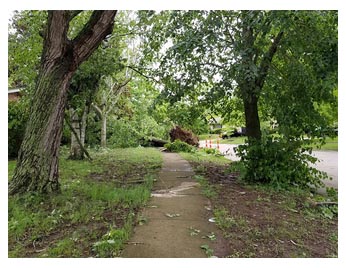
By Emily Swihart
Spring showers, Summer thunderstorms, Winter dusting of snow, are familiar weather events for Midwesterners, but as climate changes so do weather events. Extreme weather is increasing in Illinois.
Over the past 120 years, significant changes have occurred that are causing more extreme weather events, according to a recently published report from The Nature Conservancy in Illinois, “An Assessment of the Impacts of Climate Change in Illinois.”
Heat waves have increased, and as a result, Summer storm intensity has increased. The number of extremely cold days, with temperatures less than 32°F, will decrease and the freeze-free season will be extended. Warmer Winter temperatures result in heavy rain and snow events.
The impact of climate change is not limited to humans. Plants, especially long-lived plants, such as trees, are affected by these changes, too.
“So many of us love the trees in our lives and it can be devastating to see one fail because of a weather event. Taking actions before and after a storm can help promote tree resilience and longevity,” said Emily Swihart, University of Illinois Extension horticulture educator.
Regardless of the type of storm, healthy trees are better able to withstand severe weather. Healthy trees are well balanced in form, free from disease and injury, and have adequate root systems.
“Proper, regular care of young trees contributes to the development of healthy mature trees,” Swihart said. “Planting the right tree in the right place is the first step to having resilient trees.”
Tree species vary in site condition preferences and tolerances so matching tree requirements to site conditions will promote its establishment and overall health. Assessing a tree’s form and making proper pruning cuts when necessary, can create a canopy that is well balanced, encourages a single leader, and has strong branch attachment angles. Providing supplemental water to young trees during times of drought encourages root system development. Strong root systems support healthy canopies by providing adequate amounts of water and nutrients and help anchor the tree.
During a severe weather event, extra stress is put on the tree. Snow and ice storms add extra weight to the branches and cause breaking or failure. High winds can push trees over in an event known as wind throw when root systems are not capable of resisting the extra force put on the canopy. Winds may cause tree trunks to fail at weak points, or trunks may sustain damage due to twisting of the canopy.
Drought stress can cause short- and long-term damage to trees. Extreme heat can contribute to canopy dieback and health decline. Extreme cold can cause twig and branch die back or destroy flower and leaf buds.
“After a storm or weather-related event, your safety is the priority,” Swihart said. “Stay away from any fallen powerline or tree interacting with a powerline.”
Utility lines should always be considered live and dangerous. Call the utility provider before damage assessment and site clean-up.
After a weather-related event, many factors contribute to determining which trees require maintenance to restore health or have sustained fatal injuries. A certified arborist is a trained professional who can assist with assessment and tree removal if necessary. It is recommended that routine inspections be conducted on trees remaining on a site to monitor for decline or disease.
Finally, trees provide a wide variety of services in our communities, from cooling homes to creating habitat for wildlife. If trees are lost, after clean-up has occurred, replanting is the final step in recovery. Planting and caring for trees ensures that the landscape will continue to have these life-supporting species for years to come.
For more information on tree selection or care, connect with your Illinois Extension county office at go.illinois.edu/ExtensionOffice.
Emily Swihart is a horticulture educator at the University of Illinois Extension.
— University of Illinois Extension

